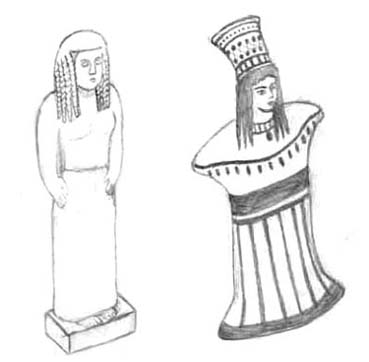Terracottas of this period have same character as bronze or stone figures. Figure of this Daedalic style(fig.4) has a particular way of representing the head, the flat face with the hair arranged in fringes like judge's wig. These figurines were produced at west coast of Asia minor, Corinth, Argos, Attic and Boeotia. This Daedalic style had flourished from the second quarter of the seventh century to its end. In Boeotia of the middle of sixth century, terracottas with flat body were produced plentifully(fig.5). Though Daedalic style still remains in her feature, the representation is more realistic. The polos, conical shaped head dress, and the dress are painted by black and red colour. Instead of these human figures, many terracottas modeled a horse, sometimes with a rider, were produced with red, black and white decorations. In east Greek, especially in Rhodes, perfume bottles in the shape of the head or whole figure of warrior, woman or animals were produced since the sixth century. Differed from other regions, in where they were made by both the hand and the mould, these terracottas are made by the mould only. They were exported throughout the Greek world and beyond, especially into Etruria. In Athens, plenty of seated figures of women were produced from
510 to 470 B.C. It was made from one mould, the long dress covered
whole length except for the head and the toes. Since some figure
have Aegis on her breast, an attribute of Athena, it is suggested
that they represent the lost statue of Athena Polias.
 |